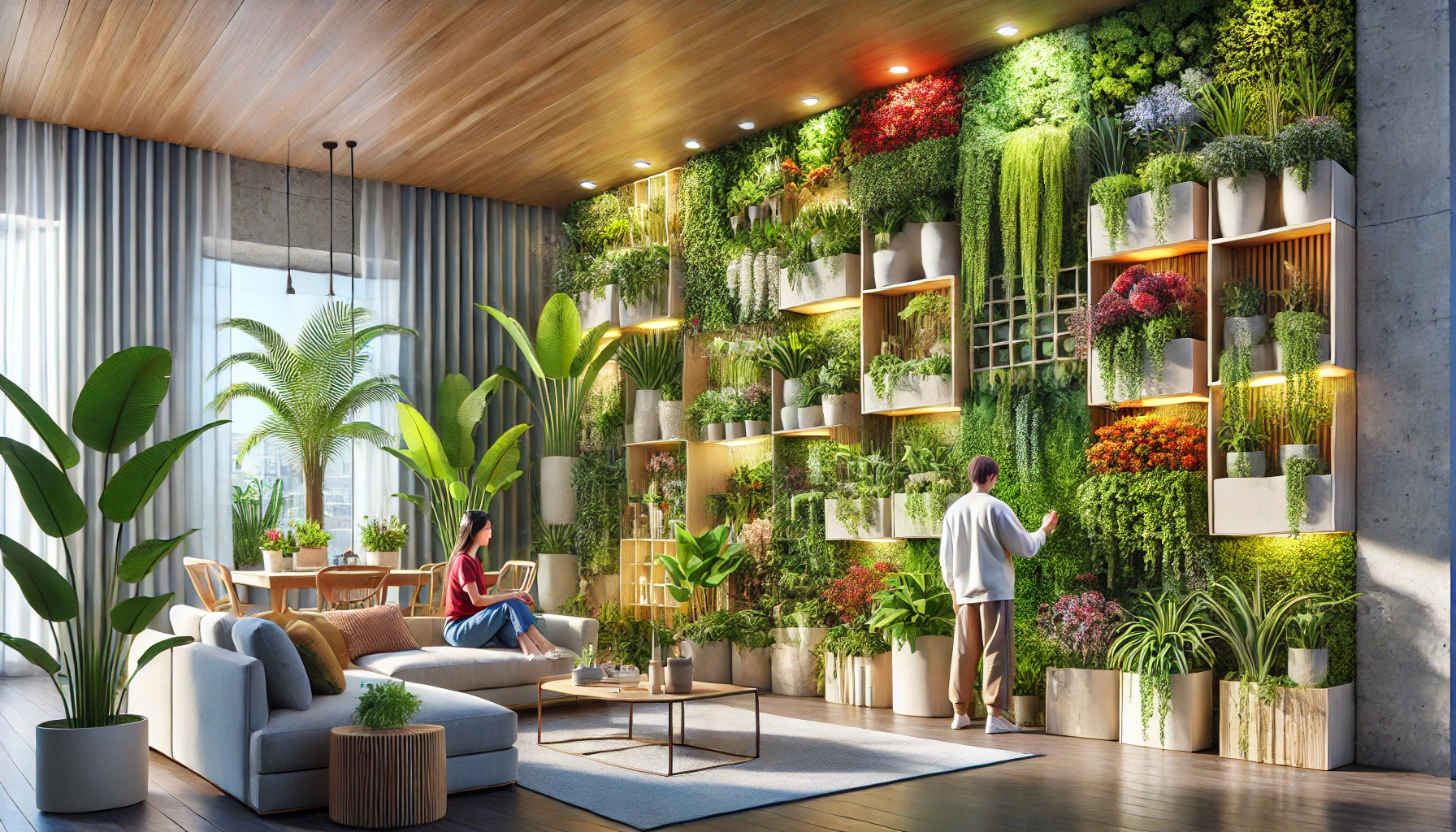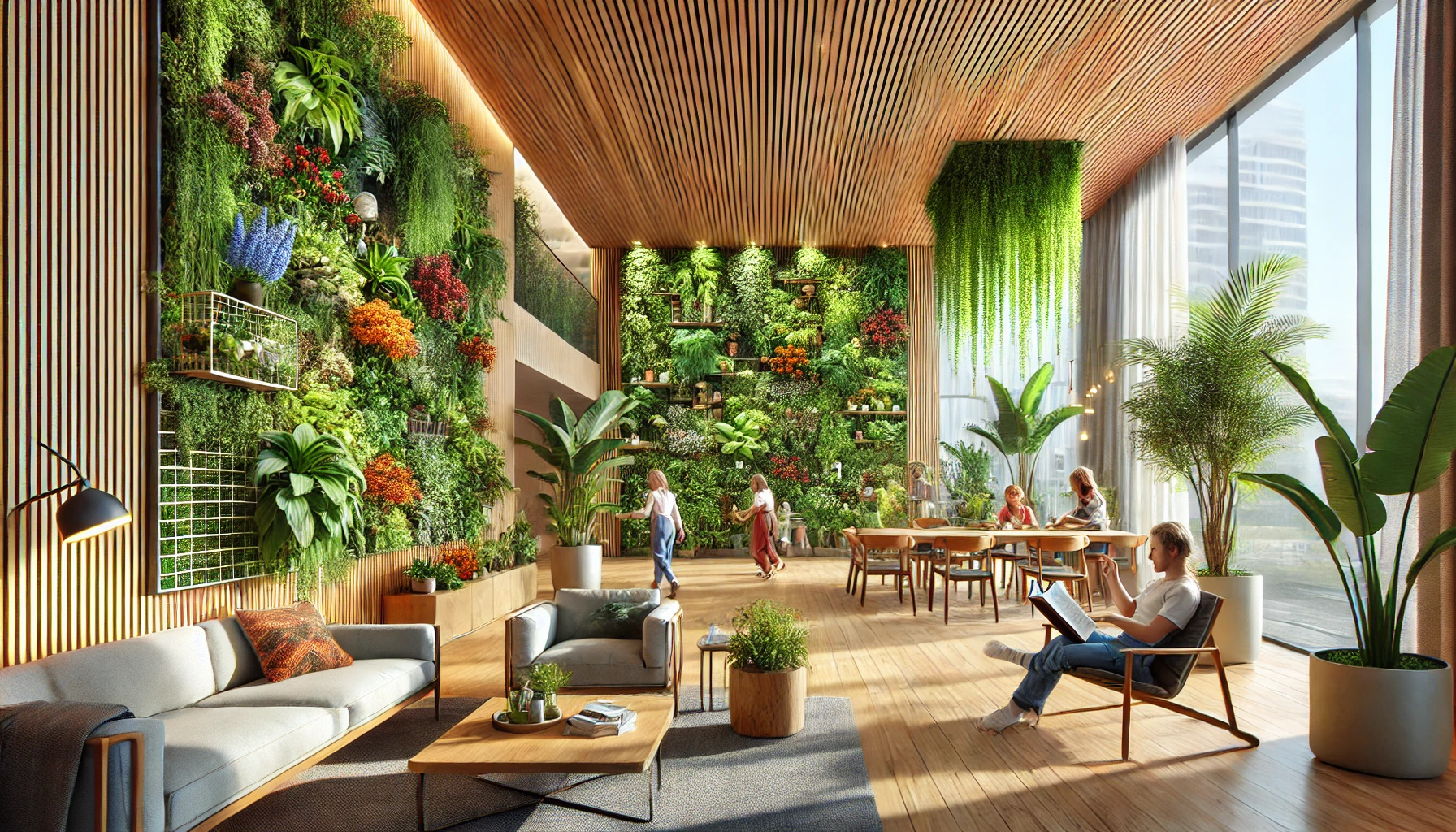Indoor Living Wall Planters are vertical arrangements of plants installed on walls to create a lush, natural aesthetic within indoor spaces.
This innovative approach to incorporating greenery into homes has gained immense popularity in recent years, as homeowners and interior designers alike seek to bring nature into living environments.
From small apartments to expansive homes, the trend of indoor plant aesthetics is a testament to the growing desire for biophilic design—an approach that connects people with nature through thoughtful architecture and decor.
Bringing plants indoors offers numerous benefits, from improving air quality to creating a calming and inviting atmosphere. Indoor living wall planters serve as both functional and decorative pieces, making them an ideal choice for anyone looking to enhance their living spaces with a touch of greenery.
Indoor Living Wall Planter Ideas
Innovative Design Concepts for Modern Homes
Indoor living wall planters can be customized to suit any home’s style, whether minimalist, industrial, bohemian, or traditional. Modular planter systems, for instance, allow for flexible configurations that adapt to specific wall dimensions.
Some popular designs include geometric arrangements, cascading plant layers, and artistic shapes that act as living artwork. Incorporating LED lighting within the design can add a modern flair, highlighting the greenery even in dimly lit rooms.
For a more rustic vibe, reclaimed wood frames can be used to complement farmhouse-style interiors.
Color Schemes & Plant Varieties That Fit Different Lifestyles
Choosing the right plants and colors can greatly impact the overall effect of your living wall. Vibrant greens pair well with neutral or monochromatic interiors, while colorful foliage, such as Calatheas or Crotons, adds a splash of personality.
For low-maintenance options, consider hardy plants like pothos, philodendrons, or succulents, which thrive in various light conditions and require minimal care. If you prefer a cohesive look, consider monochromatic greenery, such as multiple shades of green, to create depth while maintaining simplicity.
Blending Planters With Existing Decor
Integrating a living wall seamlessly into your home decor involves careful consideration of materials and textures. Wooden frames, metal accents, or ceramic pots can complement furniture and fixtures.
Additionally, you can enhance the aesthetic by pairing the living wall with complementary decor items, such as natural fiber rugs, woven baskets, or soft lighting.
Hanging art pieces or mirrors adjacent to the planter can amplify the visual appeal, creating a harmonious balance between living elements and traditional decor.
The Appeal of a Large Indoor Living Wall Planter
Advantages of Having a Large Living Wall in Indoor Spaces
A large living wall serves as a striking focal point in any room. Beyond its visual appeal, it helps improve indoor air quality, dampen noise, and create a relaxing environment.
Larger installations also allow for greater plant diversity, enabling you to incorporate a variety of textures, colors, and patterns. In open-concept spaces, a large living wall can act as a natural divider, delineating areas such as dining and living rooms without the need for physical barriers.
Strategizing Space Planning for Larger Installations
To accommodate a large living wall, it’s essential to assess the available space and the wall’s structural capacity. Walls in living rooms, dining areas, or entryways are prime locations.
Ensure there’s adequate natural or artificial light and consider installing a built-in irrigation system for easy maintenance. For optimal impact, align the living wall with furniture arrangements to create a cohesive design flow.
Adding vertical shelving near the wall can also serve as a storage solution while complementing the greenery.
Choosing the Right Plants for Larger Displays
For large installations, select plants with similar care requirements to ensure uniform growth. Ferns, ivy, and spider plants are excellent choices for lush greenery, while flowering plants like orchids can add pops of color.
Mix trailing plants with upright varieties to create a dynamic, layered effect. If you want seasonal variation, include plants that bloom at different times of the year, ensuring that the living wall remains vibrant throughout all seasons.
Indoor Living Wall Planter DIY
Step-by-Step Guide to Create Your Own Living Wall
- Choose a Wall: Select a sturdy wall with sufficient light exposure.
- Design Your Layout: Sketch a plan for plant placement and frame dimensions.
- Gather Materials: Acquire a wall frame, planter pockets, mounting hardware, soil, and plants.
- Assemble the Frame: Install the frame securely on the wall, ensuring proper alignment.
- Add Plants: Fill each pocket with soil and arrange your chosen plants according to your design.
- Water and Maintain: Water the plants regularly and check for any signs of pests or diseases.
Essential Tools and Materials Needed for DIY Projects
- Wall frame or modular planter system
- Mounting brackets and screws
- High-quality potting soil
- Plants suited to indoor conditions
- A watering can or drip irrigation system
- LED grow lights (if natural light is limited)
Cost-Effective Methods for Plant Sourcing and Maintenance
Visit local nurseries or garden centers for affordable plants and supplies. For ongoing maintenance, use self-watering planters and choose low-maintenance plant species.
Regular pruning and occasional fertilization will keep your living wall healthy and vibrant. If budget is a concern, consider propagating plants from cuttings or purchasing starter plants, which are typically less expensive than mature specimens.
Choosing the Best Indoor Living Wall Planter
Factors to Consider When Selecting a Planter
When choosing a living wall planter, prioritize durability, ease of installation, and compatibility with your chosen plants. Materials like recycled plastics, stainless steel, and treated wood are both sturdy and eco-friendly.
Additionally, consider systems with built-in irrigation or water reservoirs for hassle-free upkeep. Evaluate whether the planter system can accommodate growth over time, ensuring it remains functional as plants mature.
Top Recommendations Based on Material, Design, and Functionality
Popular living wall systems range from DIY-friendly kits to professional-grade installations. Woolly pocket planters, for example, offer a modular design that’s easy to expand.
Other options include Lechuza self-watering planters, which are ideal for busy individuals, and LiveWall systems designed for large-scale projects.
Customization Options for Unique Interiors
For a truly personalized touch, consider custom-built planters tailored to your space. Collaborate with local artisans or contractors to design a system that integrates seamlessly with your home’s architecture.
Customization allows for unique materials, shapes, and sizes, ensuring your living wall stands out as a one-of-a-kind feature.
Vertical Wall Planter Indoor Options
Exploring Vertical Designs for Space Efficiency
Vertical designs are ideal for compact spaces, offering a solution that maximizes greenery without occupying valuable floor space.
Stackable planters or wall-mounted frames can fit seamlessly into kitchens, offices, or hallways. Combining vertical planters with shelving units adds functionality, allowing you to store items while showcasing greenery.
Plant Types That Thrive in Vertical Arrangements
Trailing plants like pothos, philodendrons, and string of pearls are perfect for vertical planters. Combine them with upright species like snake plants and peace lilies to create a balanced look.
For kitchen areas, consider adding herbs like basil, parsley, and mint for a practical yet decorative touch.
Maintenance Tips for Vertical Planters
Ensure proper drainage to avoid water pooling. Rotate plants periodically for even light exposure, and prune regularly to maintain the desired shape and size. Incorporating a drip irrigation system can significantly reduce maintenance efforts, especially for larger installations.
Living Wall Planter Outdoor: An Extension to Indoor Beauty
Utilizing Indoor Planters for Outdoor Decor
Many indoor planters can transition seamlessly to outdoor spaces, such as patios or balconies. Weather-resistant materials like metal or treated wood ensure durability. Outdoor living walls can serve as privacy screens, adding functionality to their aesthetic appeal.
The Transitional Beauty of Indoor-Outdoor Planters
Indoor-outdoor planters allow for seasonal flexibility. Bring them indoors during harsh weather or to refresh indoor decor, and move them outdoors in favorable conditions for a change of scenery. This adaptability makes them a versatile investment for any homeowner.

Weather Considerations and Plant Selection for Outdoor Use
Choose plants that can withstand temperature fluctuations, such as ferns, geraniums, and succulents. Protect planters from heavy rainfall or direct sunlight by placing them under eaves or shade structures.
For regions with extreme weather conditions, consider portable planter systems that can be easily relocated.
Wall Mounted Planters Indoor
Benefits of Wall-Mounted Planters for Small Spaces
Wall-mounted planters free up floor space while adding greenery to compact rooms. They’re especially useful in studios or apartments where space is limited. By elevating plants to eye level, these planters create a visual impact that maximizes the perception of space.
Creative Mounting Techniques for Modern Interiors
Experiment with asymmetrical layouts, mix-and-match frames, or use floating shelves for a unique look. Magnetic planters are another innovative option for metal surfaces. For an artistic flair, arrange multiple small planters in a mosaic pattern, creating a living gallery wall.
Design Challenges and Solutions for Studio Apartments and Condos
In smaller spaces, opt for lightweight materials and modular designs that are easy to install and rearrange. Use neutral colors to avoid overwhelming the space, and choose plants that thrive in low light. If natural light is scarce, supplement with strategically placed LED grow lights.
Vertical Wall Planter Outdoor: Expanding the Green Horizon
Creating Stunning Vertical Gardens Outside
Vertical gardens can transform blank outdoor walls into vibrant green spaces. Use tiered planters or trellises to build multi-layered designs that add depth and dimension. Incorporating climbing plants like jasmine or clematis can enhance the vertical aesthetic while providing seasonal blooms.
Challenges Posed by Weather and Environment
Outdoor vertical planters must withstand wind, rain, and sunlight. Secure mounting and weather-resistant materials are essential for long-lasting installations. Regularly inspect the structure for wear and tear, and replace components as needed to ensure stability.
Long-Term Sustainability of Outdoor Vertical Planters
Choose native or drought-tolerant plants to reduce water usage and maintenance. Incorporate rainwater harvesting systems or drip irrigation to support sustainable gardening practices.
Companion planting—pairing plants with complementary growth habits—can also improve biodiversity and reduce pest issues.
Indoor living wall planters are a versatile and stylish way to embrace greenery in any space. Whether you’re creating a small DIY project or investing in a large installation, these planters offer endless possibilities to enhance your home’s aesthetic and well-being.
With thoughtful planning and regular care, your living wall can thrive as a beautiful and functional feature for years to come.


It’s inspiring to see how vertical gardens can turn a space into a lush oasis. What really caught my eye is how these walls can make a space look better and also improve air quality and mental health. But, I have to wonder, how sustainable are living walls in the long run? Do they need a lot of upkeep or special conditions to grow well indoors?
I’d love to hear your thoughts on making these beautiful walls practical for everyday homes.
Here’s a shorter reply:
Thank you! 😊 Vertical gardens are not only beautiful but also sustainable with the right setup. Most systems use efficient irrigation and low-maintenance plants like pothos or succulents, making upkeep manageable. For indoor spaces, grow lights and modular systems can make them practical for everyday homes. Let me know if you’d like tips to get started!